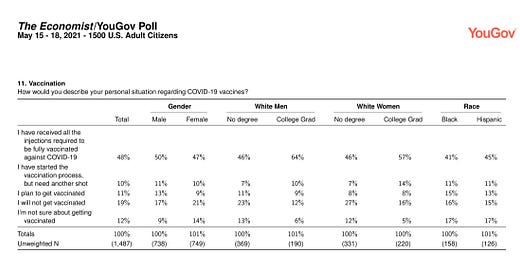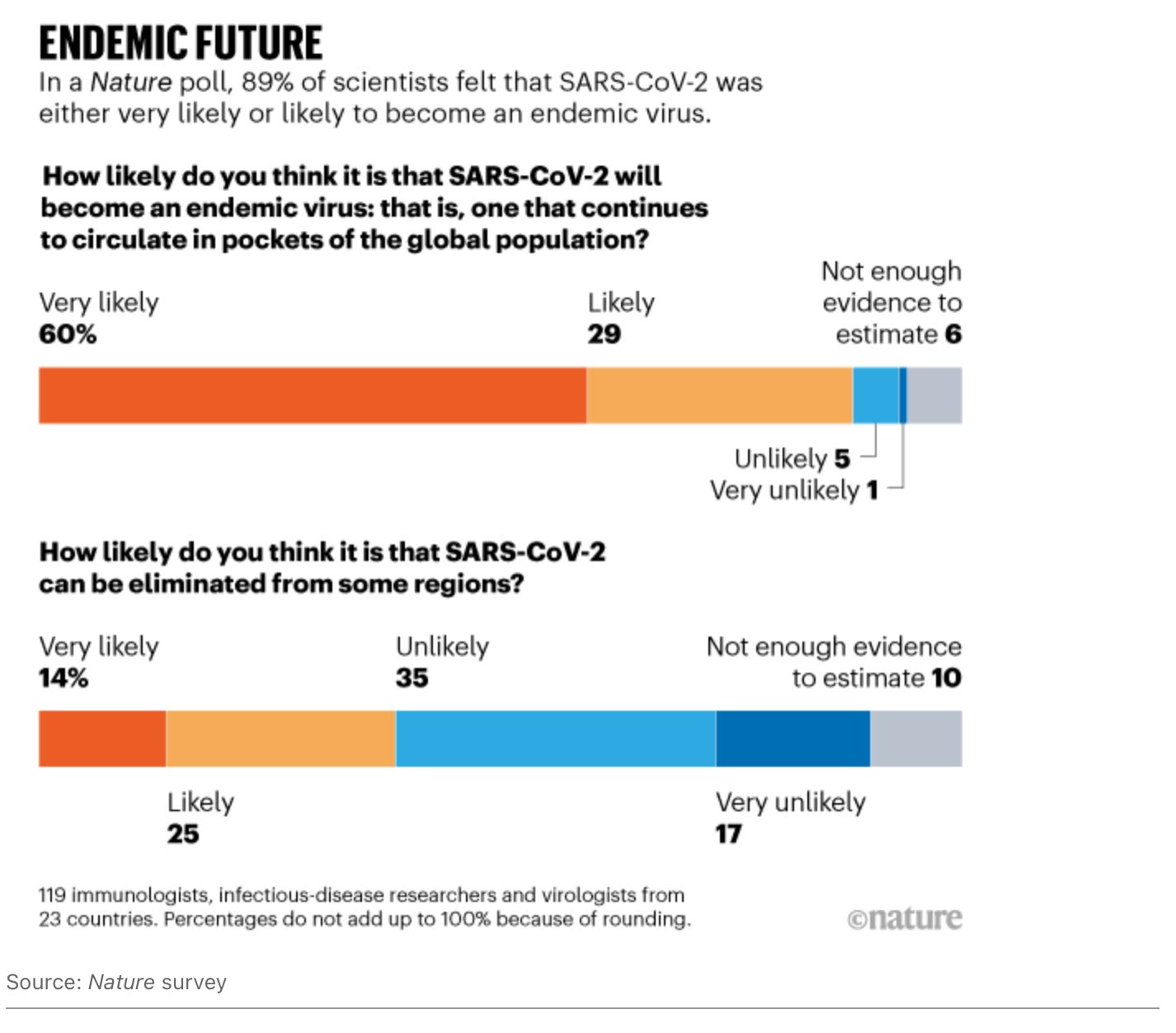The Immunity Treadmill: How covid-19 vaccine resistance could perpetually push herd immunity out of reach
Collective resistance depends on how many unvaccinated people have already been infected, how many of them have immunity, and where they live.
I am sitting at a bar in Washington, DC waiting to get drinks and an early with an old friend. Everyone around me looks awkward. People are standing ever-so-slightly farther away than they did In The Before Time. Hand sanitizer comes in and out of purses like people are (still) avoiding the plague.
I’m sure I look off too; many of us haven’t been out to get dinner indoors in over a year. When my friend joins me, I’ll probably order a hamburger and a beer. Beer is one of the few things I haven’t made at home during lockdown. (My home brewing experiments did not go well).
Over time, I suspect we will all readjust to life in public. But how long will that take? At current rates, some scientists estimate it will take months before ~70% — one speculation of the herd immunity threshold for covid-19 — of people are vaccinated.
But the problem is not just one of projection; to estimate the likely share of the population with herd immunity, we also need to know (a) how many people will refuse to get vaccinated, and (b) how many of those will gain natural immunity, which epidemiologists find probably lasts longer than eight months.
This post makes an attempt at that math. Partly because I really like sitting at this bar and would like more people to feel comfortable doing so, but mostly because this is an interesting and important question.
First, let’s use sample surveys to figure out the likely rate of vaccine hesitancy in the population. A poll from The Economist and YouGov this week found that 48% of adults report being fully vaccinated against covid-19. This is identical to the share the CDC reports. An additional 10% say they have started the process. That brings the immediately potentially vaccinated population up to 58%. On top of that, 11% say they plan to get vaccinated, bringing the total to 69% — just on the cusp of the low threshold for herd immunity.
This is not a large margin for error. Nineteen percent of people say they will not get vaccinated, and an additional 12% are skeptical of the jab themselves. We would naively assume that this one-third of the population would be the barrier between life as normal and rolling lockdowns for the foreseeable future. But some of them are likely to have natural antibodies to the virus as a result of contracting it earlier.
The herd immunity threshold largely depends on what share of vax-reluctant people we estimate being infected so far. Here, we have to engage in some fuzzy math, as there are no reliable estimates (yet) for this subgroup. To date, there have been 33 million reported covid-19 cases in the US. (The real number, due to lack of reporting, is probably higher.) That’s about 13% of the adult population. If you assume there are no differences in disease prevalence between the vaccinated and vax-reluctant group, a naive guess would be that 13% them — or an additional (12+19) * 0.13 = 4% of the overall population — will have natural immunity in some form. This assumption of equal prevalence is probably wrong, since anti-vaxers are also less likely to mask or social distance. This number could be higher as high as 6 or 7 percent. (Again, this is fuzzy math).
If you add on the naturally-immune vax-reluctant group to the share of adult who say they have to will get fully vaccinated, you come out estimating about 73-76% of the population will have some form of immunity to covid-19 by the end of the year. But this depends on what type of immunity people get after they have contracted and recovered from the virus.
It also depends on what the threshold for herd immunity will be. If it’s 70%, which is on the low end, we may approach normality soon. But if we need 90% of people to be vaccinated in order to return to a normal state of society and state of mind, we will probably never reach herd immunity.
One caveat is that people in urban areas or states with lots of Democrats, who are disproportionately more likely to receive the covid-19 vaccine, are much more likely to reach herd immunity. The Census Bureau’s Household Pulse survey shows that 9% of Virginians say they will “definitely” or “probably” not get a covid-19 vaccine. Across the Potomac river in Washington, D.C., that number is 4%. For what it’s worth, I think these are probably underestimates, as the Census numbers also show that 76% of adults say they have received at least one dose of the vaccine This is at least 16 percentage points too high; the CDC number is 60% today. But even at this level, people in DC will hit herd immunity sooner or later.
The poor residents of Wyoming, however, where 28% of people are vaccine-hesitant, will have to suffer from the disease in order to get their antibodies. And this exposes herd immunity to its third threat: whether vaccines and natural antibodies will continue to be effective against mutations of the virus. That is true so far, but it might not be true in the future.
Circulating vaccine-resistant mutations could easily push the effective immune proportion of the population below the central estimate of the herd immunity threshold. If the percent of Americans who are (a) anti-vaccine and (b) losing immunity to time or new variants is high enough, our collective approach towards normality will proceed endlessly — forever pushing herd immunity out of reach. We will be like a runner on a treadmill, pushed away from the goal no matter how long we run.
. . .
In a Nature poll released earlier this year, 70% of 119 scientists surveyed said they believed covid-19 would become an endemic virus — one that circulates in pockets of the global population for the foreseeable future. Six percent said we don’t have enough evidence to estimate the likelihood of perpetual covid.
For what it’s worth, given my reliance on fuzzy math in this post, I am comfortable in the “we don’t have enough evidence” camp. But I am much closer to arguing we will never hit nationwide herd immunity than I am thinking we will make it.
. . .
I finished this post after I got home from the bar. My vaccinated friend and I had a great time, free from the worry of contracting a deadly virus. We are lucky to be surrounded by pro-vaccine neighbors. Not everyone will be afforded the luxury of being so lucky.






I did a little epidemiology in grad school. Emphasis on the adjective. It would be useful to read what professional epidemiologists have to say about the statistical analyses they have to do with fuzzy math, and their techniques.